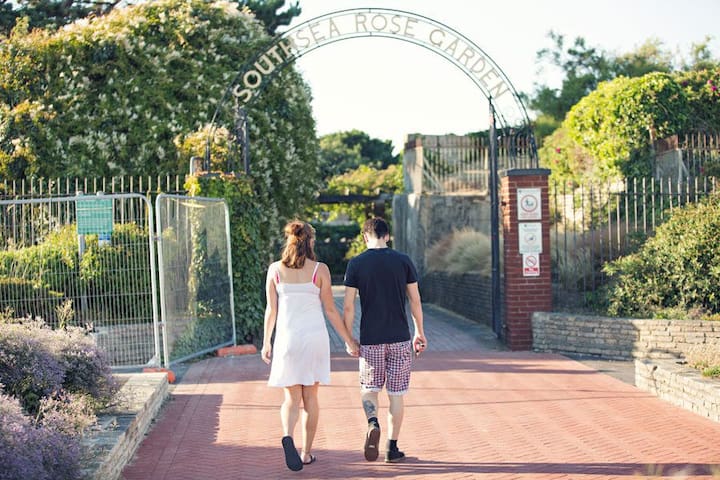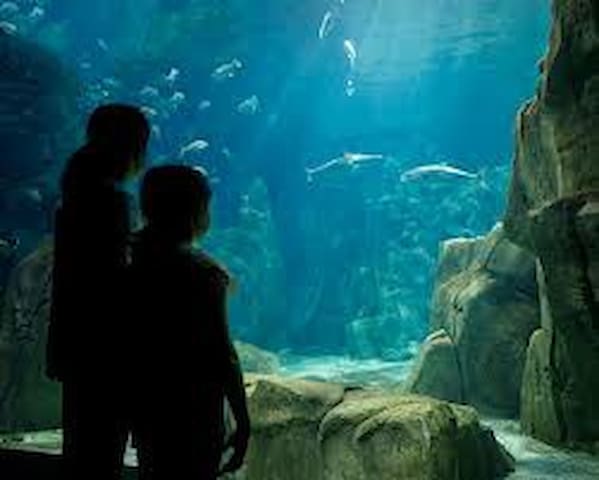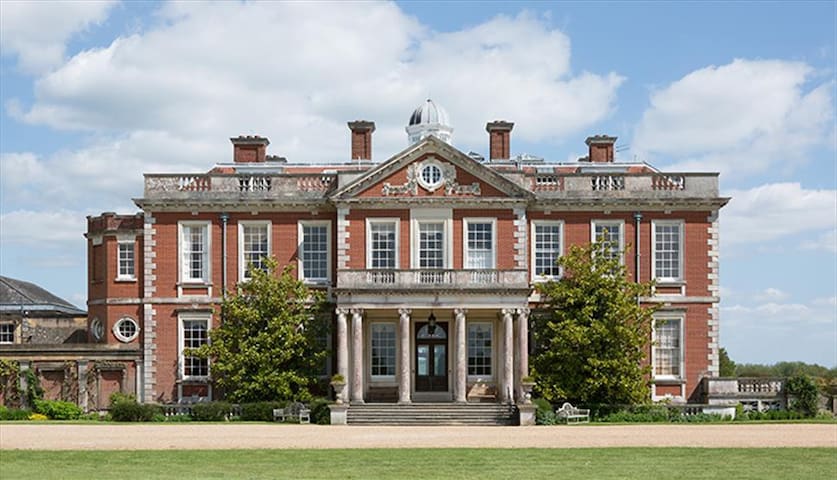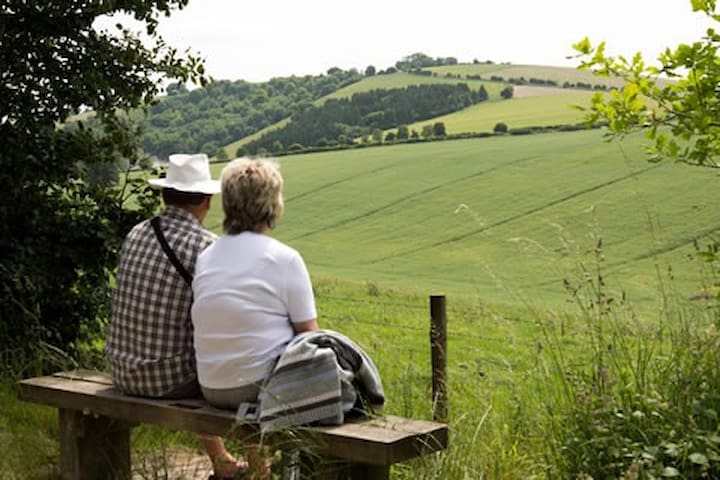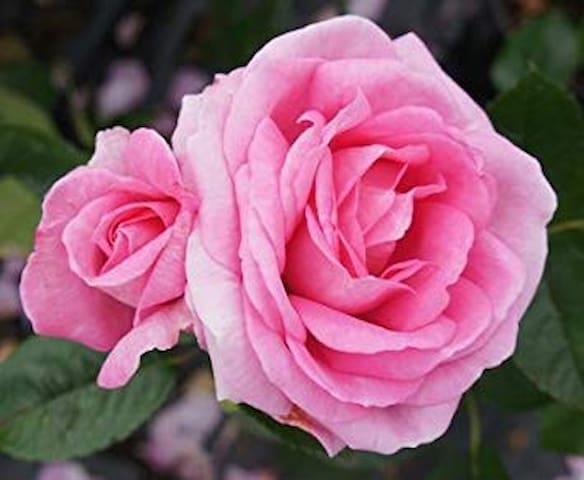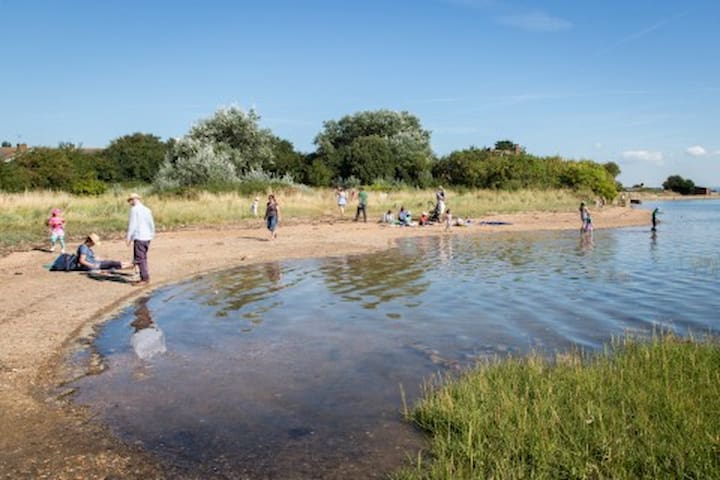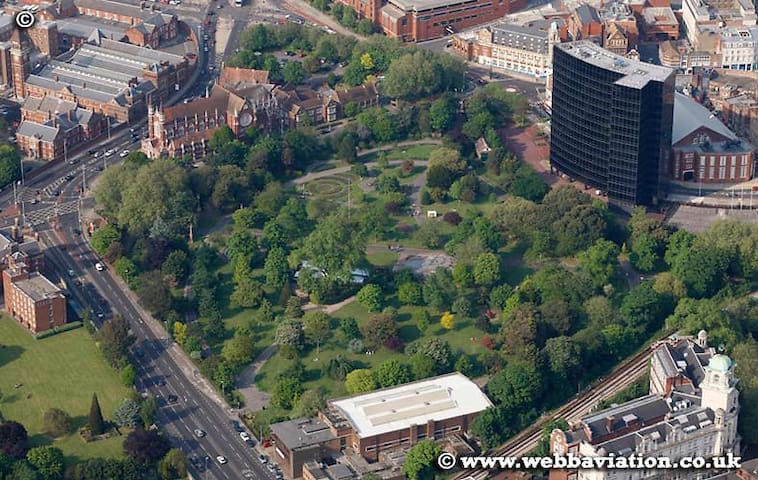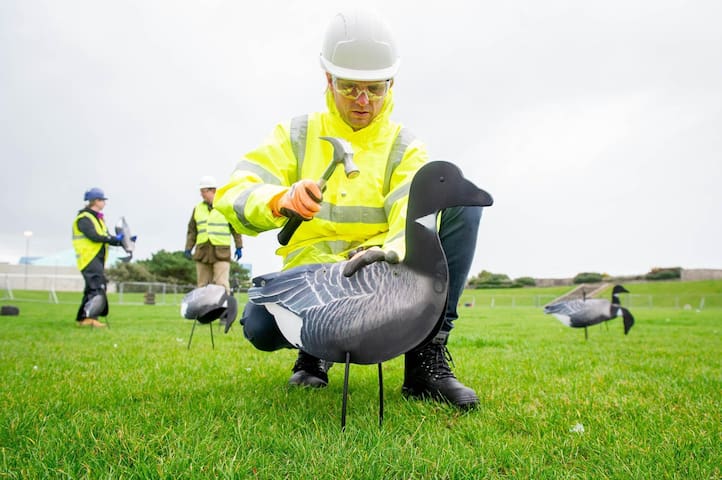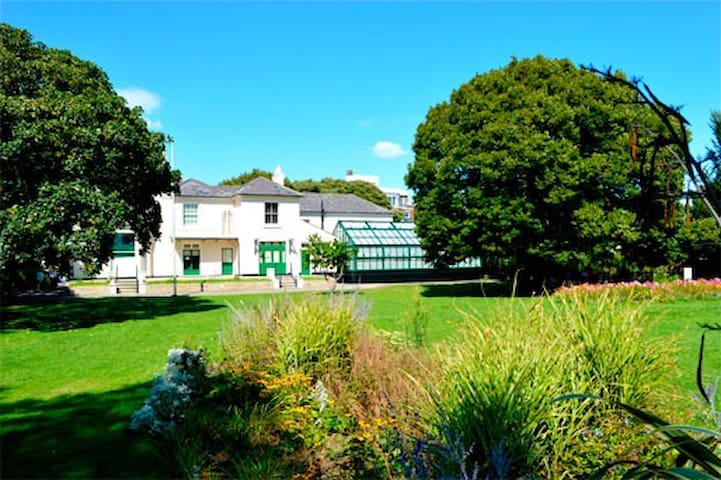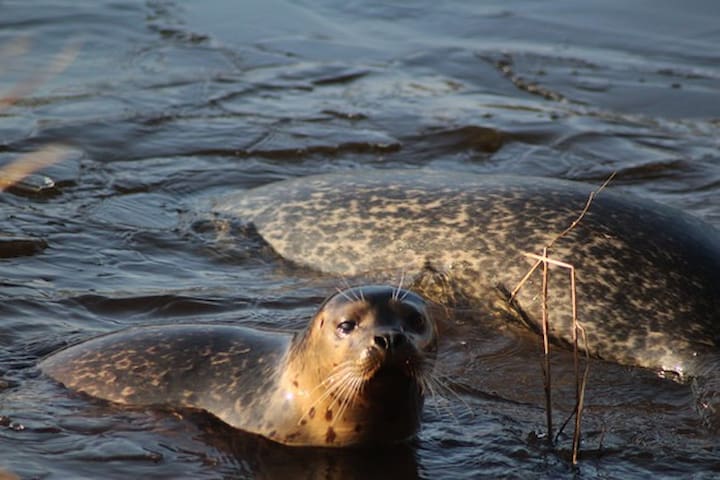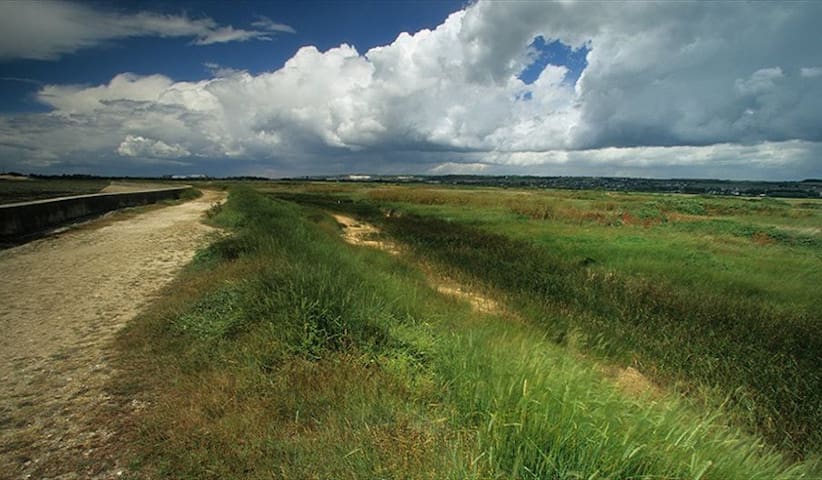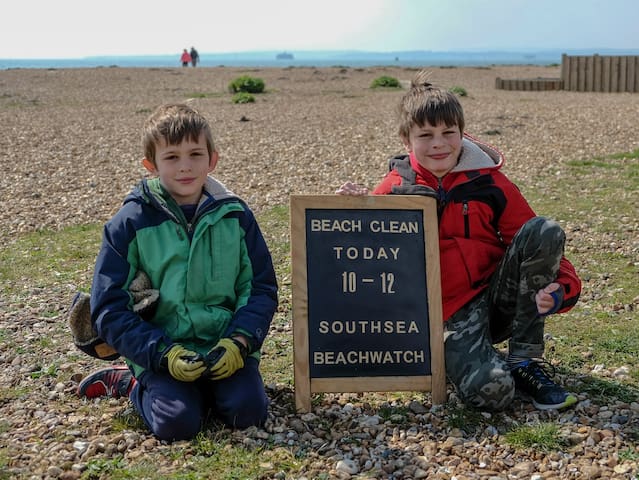Parks & Nature
On Southsea’s sunny seafront there’s a pretty spot with some compelling history. Actually, there are quite a few. Most of them are fairly well-known (no-one’s going to miss the Naval Memorial), but few Portsmuthians seem to be aware of Lumps Fort. Certainly, almost nobody knows it by that name. That’s because Lumps Fort doesn’t really exist anymore. The fortified walls remain, as well as a few mounts for defensive guns and the like. These days, however, the fort is better known for being the home of Southsea Rose Garden.
The “current” fort was built in the mid-to-late 1800s, but it has been a fortification since at least as far back as 1805, possibly dating back centuries. Part of the semaphore line between London and HMNB Portsmouth ran through Lumps – but as a good chunk of the fort fell into the sea during this period, it doesn’t seem like it was particularly well-looked-after even then.
The fort’s main claim to fame was serving as the training facility for Operation Frankton, where, in 1942, a team of Royal Marines executed a daring commando raid on the German-occupied port of Bordeaux. The mission led to six ships being successfully sabotaged, at the cost of the eventual deaths of all but two of the marines. A plaque outside Lumps Fort commemorates the “Cockleshell Heroes” (named after the “cockle” kayaks used) involved in this imaginative and courageous raid. A film of the same name was made in 1955.
The majority of the old fort is now occupied by Southsea Rose Garden. In bloom, the garden is stunning, and is said to have up to forty varieties of roses on display.
The Rose Garden also contains what seems to be the only clue that Portsmouth is twinned with the city of Maizuru, in Japan. The “Japanese Garden” might be a little dilapidated now, but it stills possesses a bit of the charm it must have had when it was new.
While pretty, the Japanese Garden is fairly small, so when you’ve finished with it a brief stroll will lead you up a few steps and to the top of the fort’s walls, where, on a good day, you’ll get a fantastic view over the Solent to the Isle of Wight. The numerous memorials on the nearby benches suggest the views have made a similar impression on more than a few people.
Once you’re had your fill of Lumps Fort and Nearby you’ll find Southsea Model Village, as well as Canoe Lake and Portsmouth’s own Natural History Museum, Cumberland House – all well worth a look.
8 當地人推薦
The Rose Gardens
On Southsea’s sunny seafront there’s a pretty spot with some compelling history. Actually, there are quite a few. Most of them are fairly well-known (no-one’s going to miss the Naval Memorial), but few Portsmuthians seem to be aware of Lumps Fort. Certainly, almost nobody knows it by that name. That’s because Lumps Fort doesn’t really exist anymore. The fortified walls remain, as well as a few mounts for defensive guns and the like. These days, however, the fort is better known for being the home of Southsea Rose Garden.
The “current” fort was built in the mid-to-late 1800s, but it has been a fortification since at least as far back as 1805, possibly dating back centuries. Part of the semaphore line between London and HMNB Portsmouth ran through Lumps – but as a good chunk of the fort fell into the sea during this period, it doesn’t seem like it was particularly well-looked-after even then.
The fort’s main claim to fame was serving as the training facility for Operation Frankton, where, in 1942, a team of Royal Marines executed a daring commando raid on the German-occupied port of Bordeaux. The mission led to six ships being successfully sabotaged, at the cost of the eventual deaths of all but two of the marines. A plaque outside Lumps Fort commemorates the “Cockleshell Heroes” (named after the “cockle” kayaks used) involved in this imaginative and courageous raid. A film of the same name was made in 1955.
The majority of the old fort is now occupied by Southsea Rose Garden. In bloom, the garden is stunning, and is said to have up to forty varieties of roses on display.
The Rose Garden also contains what seems to be the only clue that Portsmouth is twinned with the city of Maizuru, in Japan. The “Japanese Garden” might be a little dilapidated now, but it stills possesses a bit of the charm it must have had when it was new.
While pretty, the Japanese Garden is fairly small, so when you’ve finished with it a brief stroll will lead you up a few steps and to the top of the fort’s walls, where, on a good day, you’ll get a fantastic view over the Solent to the Isle of Wight. The numerous memorials on the nearby benches suggest the views have made a similar impression on more than a few people.
Once you’re had your fill of Lumps Fort and Nearby you’ll find Southsea Model Village, as well as Canoe Lake and Portsmouth’s own Natural History Museum, Cumberland House – all well worth a look.
The Common is home to a remarkable collection of mature elm trees, believed to be the oldest and largest surviving in Hampshire, which have escaped Dutch elm disease owing to their isolation. The majority of the larger trees are Huntingdon Elms planted in the 1920s, but nearer the entrance to the Skate Park there is a fine example of a hybrid of the Siberian Elm Ulmus pumila. Huntingdon Elms once lined the Ladies' Mile—an avenue through the centre of the Common—but many were lost in the Great Storm of 1987 and replaced by the Dutch hybrid elm cultivar 'Lobel'.
The Ladies' Mile is also home to several semi-mature Canary Island Date Palms Phoenix canariensis. Planted in 1996, these palms are now some of the largest in the UK and for the last few years have fruited and produced viable seed, the first time this species of palm has been recorded doing so in the UK. Other palms growing close to the Common include Trachycarpus fortunei, (Ladies' Mile, Rock Gardens and Rose Garden), Chamaerops humilis (in front of the Pyramids Centre), Butia capitata (in Burgoyne Gardens) and Brahea armata, (Canoe Lake and D-Day Island). Many Cordyline australis are also planted in the area, though these are not true palms, but more closely related to yuccas and agaves.
Lovely place for a quiet walk. safe for young kids on their bikes or scooters. It has a couple of cafes, and even a small garden centre! There is a skate-park for the older kids, and a free splash area for the younger ones during the summer months.
Every year some superb events are held on the common - including "Victorious" music festival, the International Kite Festival, Race for Life, The Great South Run, Forces Day, Shire Horses etc
38 當地人推薦
南海公園
29 Osborne RoadThe Common is home to a remarkable collection of mature elm trees, believed to be the oldest and largest surviving in Hampshire, which have escaped Dutch elm disease owing to their isolation. The majority of the larger trees are Huntingdon Elms planted in the 1920s, but nearer the entrance to the Skate Park there is a fine example of a hybrid of the Siberian Elm Ulmus pumila. Huntingdon Elms once lined the Ladies' Mile—an avenue through the centre of the Common—but many were lost in the Great Storm of 1987 and replaced by the Dutch hybrid elm cultivar 'Lobel'.
The Ladies' Mile is also home to several semi-mature Canary Island Date Palms Phoenix canariensis. Planted in 1996, these palms are now some of the largest in the UK and for the last few years have fruited and produced viable seed, the first time this species of palm has been recorded doing so in the UK. Other palms growing close to the Common include Trachycarpus fortunei, (Ladies' Mile, Rock Gardens and Rose Garden), Chamaerops humilis (in front of the Pyramids Centre), Butia capitata (in Burgoyne Gardens) and Brahea armata, (Canoe Lake and D-Day Island). Many Cordyline australis are also planted in the area, though these are not true palms, but more closely related to yuccas and agaves.
Lovely place for a quiet walk. safe for young kids on their bikes or scooters. It has a couple of cafes, and even a small garden centre! There is a skate-park for the older kids, and a free splash area for the younger ones during the summer months.
Every year some superb events are held on the common - including "Victorious" music festival, the International Kite Festival, Race for Life, The Great South Run, Forces Day, Shire Horses etc
Overlooking the busy but beautiful Solent, Portsmouth's Blue Reef Aquarium takes visitors on the ultimate undersea safari.
From the rich variety of British waters to the beauty of a tropical coral reef and more than 40 other displays - including a fantastic otter holt - the aquarium offers a fascinating window into the hidden world beneath the waves. At the aquarium's heart is a giant tropical reef tank that is home to a variety of tropical sharks and stingrays, as well as hundreds of brightly-coloured reef fish. Visitors are able to get up close to these creatures and see life from the sea bed, thanks to the underwater, walk-through tunnel.
During the summer, families can take a break in the outside play area and splash pool. There are also a number of events running throughout the year, including animal feeding and educational talks. A full list of events and feeding times can be found on the website.
Some of the sea creatures on display include rays, black tip reef sharks, crested horn sharks, zebra sharks, otters, terrapins, frilled dragons, spider crabs and much more.
29 當地人推薦
藍礁水族館朴茨茅斯
Clarence EsplanadeOverlooking the busy but beautiful Solent, Portsmouth's Blue Reef Aquarium takes visitors on the ultimate undersea safari.
From the rich variety of British waters to the beauty of a tropical coral reef and more than 40 other displays - including a fantastic otter holt - the aquarium offers a fascinating window into the hidden world beneath the waves. At the aquarium's heart is a giant tropical reef tank that is home to a variety of tropical sharks and stingrays, as well as hundreds of brightly-coloured reef fish. Visitors are able to get up close to these creatures and see life from the sea bed, thanks to the underwater, walk-through tunnel.
During the summer, families can take a break in the outside play area and splash pool. There are also a number of events running throughout the year, including animal feeding and educational talks. A full list of events and feeding times can be found on the website.
Some of the sea creatures on display include rays, black tip reef sharks, crested horn sharks, zebra sharks, otters, terrapins, frilled dragons, spider crabs and much more.
Southsea Rock Gardens is a well known and popular location on Southsea seafront. The gardens comprise 1.35 hectares of landscaped ornamental parkland with rich horticultural diversity and a history dating back to the 1920’s. The Rock Gardens were built in the early 1920’s during the years of the depression following the First World War. At that time Central Government were giving loans and grants to local authorities for schemes that would provide jobs for the many unemployed. The gardens were landscaped by hand and planted with mainly evergreen shrubs, herbaceous plants, alpines and a large number of annuals.
The gardens are a secluded area away from the wide open spaces of Southsea Common, and the Millennium Walkway running along the seafront. It is very popular with visitors for the sheltered and tranquil nature of the gardens, and the appeal of the vast range of trees shrubs and borders
Plants are constantly being sourced with the intention of building up a distinctive collection of flora not normally seen in publicly open areas. There are two ponds and a fountain, with associated wetland plants and fish stock. An interpretation board at the roadside entrance gives an illustrated history of the gardens.
9 當地人推薦
南海岸石頭花園
Southsea Rock Gardens is a well known and popular location on Southsea seafront. The gardens comprise 1.35 hectares of landscaped ornamental parkland with rich horticultural diversity and a history dating back to the 1920’s. The Rock Gardens were built in the early 1920’s during the years of the depression following the First World War. At that time Central Government were giving loans and grants to local authorities for schemes that would provide jobs for the many unemployed. The gardens were landscaped by hand and planted with mainly evergreen shrubs, herbaceous plants, alpines and a large number of annuals.
The gardens are a secluded area away from the wide open spaces of Southsea Common, and the Millennium Walkway running along the seafront. It is very popular with visitors for the sheltered and tranquil nature of the gardens, and the appeal of the vast range of trees shrubs and borders
Plants are constantly being sourced with the intention of building up a distinctive collection of flora not normally seen in publicly open areas. There are two ponds and a fountain, with associated wetland plants and fish stock. An interpretation board at the roadside entrance gives an illustrated history of the gardens.
Stansted Park with it's House & Grounds stands in 1800 acres of parkland and ancient forest within the South Downs National Park.
In 1983 the 10th Earl of Bessborough gave Stansted Park, the Arboretum, his family home and its beautiful contents to the public. The state rooms are furnished as though the 10th Earl was still at home, giving the visitor a real sense of a bygone era. The extensive servants’ quarters below stairs are filled with historic artefacts that are brought to life by the very knowledgeable and friendly stewards who will guide you through the vibrant history of the House.
Stansted Forest provides many routes for walkers and cyclists and is enjoyed by thousands of visitors each year. The estate is carefully managed to conserve wildlife habitats which means Stansted is home to a variety of unusual birds, plants and insects.
The Forest, Grounds and Walled Gardens are open all year, this includes the Arboretum, The Pavilion Tearoom, The Stansted Park Garden Centre, The Farm Shop, The Maze, Miniature Railway and the Play area.
34 當地人推薦
Stansted House
Stansted Park with it's House & Grounds stands in 1800 acres of parkland and ancient forest within the South Downs National Park.
In 1983 the 10th Earl of Bessborough gave Stansted Park, the Arboretum, his family home and its beautiful contents to the public. The state rooms are furnished as though the 10th Earl was still at home, giving the visitor a real sense of a bygone era. The extensive servants’ quarters below stairs are filled with historic artefacts that are brought to life by the very knowledgeable and friendly stewards who will guide you through the vibrant history of the House.
Stansted Forest provides many routes for walkers and cyclists and is enjoyed by thousands of visitors each year. The estate is carefully managed to conserve wildlife habitats which means Stansted is home to a variety of unusual birds, plants and insects.
The Forest, Grounds and Walled Gardens are open all year, this includes the Arboretum, The Pavilion Tearoom, The Stansted Park Garden Centre, The Farm Shop, The Maze, Miniature Railway and the Play area.
With over 2000 acres of downland and woodland, Queen Elizabeth Country Park is located in the South Downs National Park and makes for a great day out for all. Enjoy the views at the top of Butser Hill, the highest point on the South Downs, or let your children enjoy the play areas – older children will love the adventure trail, and the younger ones with have great fun running around the animal themed play area.
For those wanting something a bit more adventurous, there are plenty of walking routes to choose from, whether you’re looking for a short stroll or a longer ramble. Or, take to the trails and explore the park on your bike! The park offers a variety of mountain bike trails for both the beginner and the keen cyclist.
Outdoor Activities: Within the grounds of Queen Elizabeth Country Park there are some fantastic adventure sports for people and groups of all ages, such as off road driver training, Paragliding/Hang gliding and Wayfaring and orienteering.
Cycling: Queen Elizabeth Country Park offers a number of exhilarating cycle routes. The country park has trails for both the beginner and the keen cyclist.
Walking: Enjoy over 2,000 acres of open access woodland and downland to explore throughout the seasons. Walks and route details can be picked up from the visitors centre or downloaded from the park's website.
Play areas: Let the children loose in the fantastic play areas. For children aged eight and over there is an extensive range of equipment at the Adventure Play Trail near the Juniper BBQ site. Also for children under 8 years there is a range of animal themed play equipment in the Tots Play Area close to the Visitor Centre.
Dogs are welcome in the country park but please be aware that livestock grave on Butser Hill.
Queen Elizabeth Park's Cafe is a great place to relax after exploring the park. The cafe offers home-made, locally sourced food, meals, snacks and cakes. Plus tea, coffee and hot chocolate. The cafe is open weekdays from 10am and weekend from 9.30am.
32 當地人推薦
Queen Elizabeth Country Park Visitor Centre
South Downs WayWith over 2000 acres of downland and woodland, Queen Elizabeth Country Park is located in the South Downs National Park and makes for a great day out for all. Enjoy the views at the top of Butser Hill, the highest point on the South Downs, or let your children enjoy the play areas – older children will love the adventure trail, and the younger ones with have great fun running around the animal themed play area.
For those wanting something a bit more adventurous, there are plenty of walking routes to choose from, whether you’re looking for a short stroll or a longer ramble. Or, take to the trails and explore the park on your bike! The park offers a variety of mountain bike trails for both the beginner and the keen cyclist.
Outdoor Activities: Within the grounds of Queen Elizabeth Country Park there are some fantastic adventure sports for people and groups of all ages, such as off road driver training, Paragliding/Hang gliding and Wayfaring and orienteering.
Cycling: Queen Elizabeth Country Park offers a number of exhilarating cycle routes. The country park has trails for both the beginner and the keen cyclist.
Walking: Enjoy over 2,000 acres of open access woodland and downland to explore throughout the seasons. Walks and route details can be picked up from the visitors centre or downloaded from the park's website.
Play areas: Let the children loose in the fantastic play areas. For children aged eight and over there is an extensive range of equipment at the Adventure Play Trail near the Juniper BBQ site. Also for children under 8 years there is a range of animal themed play equipment in the Tots Play Area close to the Visitor Centre.
Dogs are welcome in the country park but please be aware that livestock grave on Butser Hill.
Queen Elizabeth Park's Cafe is a great place to relax after exploring the park. The cafe offers home-made, locally sourced food, meals, snacks and cakes. Plus tea, coffee and hot chocolate. The cafe is open weekdays from 10am and weekend from 9.30am.
Apuldram Roses; a plant nursery specialising in Roses!
Crouchers Farm, 163 Birdham Rd, Chichester PO20 7EQ.
"Apuldram Roses was started 30 years ago and today, still remains a small family run company. Apuldram Roses believes in good, old fashioned customer service and friendly helpful advice."
If you are into roses then this is a super little nursery. Have a look at their website before you go so you have some idea of the ones you might be interested in. The whole area around here is lovely and you can stop off en route at Emsworth, Bosham or any of a multitude of garden centres along the way (but take the old road to do that!)
Apuldram Roses
163 Birdham RdApuldram Roses; a plant nursery specialising in Roses!
Crouchers Farm, 163 Birdham Rd, Chichester PO20 7EQ.
"Apuldram Roses was started 30 years ago and today, still remains a small family run company. Apuldram Roses believes in good, old fashioned customer service and friendly helpful advice."
If you are into roses then this is a super little nursery. Have a look at their website before you go so you have some idea of the ones you might be interested in. The whole area around here is lovely and you can stop off en route at Emsworth, Bosham or any of a multitude of garden centres along the way (but take the old road to do that!)
Milton Locks, in the far east of Milton at the end of the eponymous Locksway Road, is located at the Langstone Harbour entrance of the abandoned Portsmouth and Arundel Canal which began operations in 1822. Little now remains of the old lock gates, wooden as they were, although the infrastructure is still evident. There are several pubs located along the former canal path, partly delineating its route towards Landport where it ended at the eponymously named Arundel Street. Traces of the canal survive further into central Portsmouth, as the railway line from Fratton to Portsmouth and Southsea railway station, runs along the earlier canal bed. This can be most easily seen from a street called Canal Walk, just off Fratton Bridge.
Part of the former Portsmouth and Arundel Canal was located directly south of Middle Farm (later Milton Park) which was built across Portsea Island to Landport. When the canal closed in the middle of the nineteenth century, the section in Milton was filled in to form a new main road along the route of the canal, and was named Goldsmith Avenue after the local land owning Goldsmith family.
Milton Locks Nature Reserve
Milton Locks, in the far east of Milton at the end of the eponymous Locksway Road, is located at the Langstone Harbour entrance of the abandoned Portsmouth and Arundel Canal which began operations in 1822. Little now remains of the old lock gates, wooden as they were, although the infrastructure is still evident. There are several pubs located along the former canal path, partly delineating its route towards Landport where it ended at the eponymously named Arundel Street. Traces of the canal survive further into central Portsmouth, as the railway line from Fratton to Portsmouth and Southsea railway station, runs along the earlier canal bed. This can be most easily seen from a street called Canal Walk, just off Fratton Bridge.
Part of the former Portsmouth and Arundel Canal was located directly south of Middle Farm (later Milton Park) which was built across Portsea Island to Landport. When the canal closed in the middle of the nineteenth century, the section in Milton was filled in to form a new main road along the route of the canal, and was named Goldsmith Avenue after the local land owning Goldsmith family.
Millions of years ago, Mother Nature imposed Her will and carved a natural inlet into Britain’s south coast. Today her work is called ‘Langstone Harbour’.
The inlet fills at high tide before draining out, leaving muddy flats, into the Solent and English Channel. On a sunny day, one can look northwest toward the rolling hills of the West Sussex Downs; the water is sky-blue lapping onto the beach separating sea and land, the locality now a protected nature reserve. In winter, when the storms lash the South Coast of ‘The Emerald Isle’, Langstone Harbour becomes a grey place to be. Rain, whipped up by strong gales, blankets the area; it soaks any walkers to the bone. This is what Mother Nature intended, whatever season, for us to enjoy.
‘The Peoples Memorial’, built by Willie Goldfinch, at his own expense, upon the shoreline of Langston Harbour, was created as a tribute to the serving men and women of our British Armed Forces who, today, find themselves at war on foreign battlefields, and to those who pay the ultimate sacrifice and in decades long past. And, as ‘The Peoples’ Memorial’ suggests by its very name, it is a very special place for everyone, of all races, religions, creeds and political leanings, to visit, to be at peace, and to pray.
The People's Memorial
Millions of years ago, Mother Nature imposed Her will and carved a natural inlet into Britain’s south coast. Today her work is called ‘Langstone Harbour’.
The inlet fills at high tide before draining out, leaving muddy flats, into the Solent and English Channel. On a sunny day, one can look northwest toward the rolling hills of the West Sussex Downs; the water is sky-blue lapping onto the beach separating sea and land, the locality now a protected nature reserve. In winter, when the storms lash the South Coast of ‘The Emerald Isle’, Langstone Harbour becomes a grey place to be. Rain, whipped up by strong gales, blankets the area; it soaks any walkers to the bone. This is what Mother Nature intended, whatever season, for us to enjoy.
‘The Peoples Memorial’, built by Willie Goldfinch, at his own expense, upon the shoreline of Langston Harbour, was created as a tribute to the serving men and women of our British Armed Forces who, today, find themselves at war on foreign battlefields, and to those who pay the ultimate sacrifice and in decades long past. And, as ‘The Peoples’ Memorial’ suggests by its very name, it is a very special place for everyone, of all races, religions, creeds and political leanings, to visit, to be at peace, and to pray.
Victoria Park is a public park located just to the north of Portsmouth Guildhall, adjacent to Portsmouth and Southsea railway station and close to the city centre in Portsmouth, Hampshire. It was officially opened on 25 May 1878 and was the first public park to be opened in Portsmouth. It was designed by Alexander McKenzie. It has a total area of around 15 acres (61,000 m2) and is planted with trees, shrubs and flowers. The centre of the park features an enclosed area which inhabits animals such as birds, rabbits and guinea pigs.
6 當地人推薦
維多利亞公園
3 Stanhope RdVictoria Park is a public park located just to the north of Portsmouth Guildhall, adjacent to Portsmouth and Southsea railway station and close to the city centre in Portsmouth, Hampshire. It was officially opened on 25 May 1878 and was the first public park to be opened in Portsmouth. It was designed by Alexander McKenzie. It has a total area of around 15 acres (61,000 m2) and is planted with trees, shrubs and flowers. The centre of the park features an enclosed area which inhabits animals such as birds, rabbits and guinea pigs.
WATERFRONT GARDEN CENTRE
Avenue De Caen, Portsmouth PO5 3NS.
The garden centre sells plants and outdoor goods and houses a nursery to grow plants for sale. It also provides an opportunity for people with learning disabilities and volunteers to work alongside members of the team to assist with retail and growing and links with community projects, small local businesses and craftspeople to provide an outlet for their products.
Garden Centre
WATERFRONT GARDEN CENTRE
Avenue De Caen, Portsmouth PO5 3NS.
The garden centre sells plants and outdoor goods and houses a nursery to grow plants for sale. It also provides an opportunity for people with learning disabilities and volunteers to work alongside members of the team to assist with retail and growing and links with community projects, small local businesses and craftspeople to provide an outlet for their products.
October sees the arrival of the Brent Geese to southern England from Siberia. During the sea defence works a large area of Castle Field is seasonally fenced off to the public to create a refuge for them.
Natural England has chosen Castle Field for the birds until March to offset the use of Clarence Playing Field during ongoing sea defence works.
The site was set up as Clarence Playing Field - one of the birds' usual grounds - is being used as a works compound area for sea defence works.
The council was required to make an alternative provision for the birds, which arrive in large flocks from early October, by Natural England.
The field has been fenced off for the geese which migrate to the area from Siberia to feed and roost.
Decoys and audio devices will be placed within the refuge site to encourage the geese to use the area.
Tony Whitehead, for the RSPB, said the birds had flown a "marathon to be with us".
"We need to find a little bit of space for them so these sea defences can be built. You need sanctuary areas where they can feed and not be disturbed.
"There were no alternatives. It's a real blessing to have these birds," he said.
The field will be fenced off every winter for the next five years - the duration of the sea defence works - from October to March so it can be used by the geese.
The geese have however snubbed the coastal space fenced off especially for them in favour of a pitch-and-putt golf course and a cricket ground, taking up residence at the Tenth Hole golf course and nearby Portsmouth Cricket Club. A Portsmouth City Council spokeswoman said: "Castle Field was identified as the most appropriate site for the refuge area, in conjunction with Natural England. We monitor the Castle Field site weekly and will continue to do so throughout winter, sharing our findings with Natural England. We are aware of brent geese on the cricket field, however, it must be noted that they tend to move between several sites in Portsmouth."
Brent Geese are often seen around Southsea during winter months when they migrate from Siberia to feed and roost. A very small number were seen using Castle Field during winter 2020-21. In 2021 it was decided that Castle Field will remain open all year round, with Southsea's MoD field to be used as a new bird refuge for overwintering Brent Geese. The move follows a negotiated decision by Southsea Coastal Scheme officers and Natural England. A case was made to Natural England to relocate the winter refuge in order to balance the needs of the community with the protection of the Brent Geese. Most of the MoD field is already fenced off for use as a materials processing compound for the Southsea Coastal Scheme, and an additional area within this site will be fenced off as a bird refuge. The impact of the Scheme's site works on the birds will also be mitigated through the addition of visual and acoustic screening to the fence between the refuge and the compound area. Cabinet Member for Planning Policy and City Development, Councillor Hugh Mason said: "This is a great example of working cooperatively to find a solution that is acceptable to the public and meets the legal requirements of Natural England to provide an area for the internationally-protected Brent Geese. The MoD Field is currently fenced off as part of the Southsea Coastal Scheme site, which means minimal disruption will be caused by separating this additional area for the birds." This area of the MoD field will be fenced off over winter until the completion of the Southsea Coastal Scheme in 2026. Monitoring will be undertaken at regular intervals to understand how the geese are using the site. This information will be shared with Natural England.
Castle Field
Clarence EsplanadeOctober sees the arrival of the Brent Geese to southern England from Siberia. During the sea defence works a large area of Castle Field is seasonally fenced off to the public to create a refuge for them.
Natural England has chosen Castle Field for the birds until March to offset the use of Clarence Playing Field during ongoing sea defence works.
The site was set up as Clarence Playing Field - one of the birds' usual grounds - is being used as a works compound area for sea defence works.
The council was required to make an alternative provision for the birds, which arrive in large flocks from early October, by Natural England.
The field has been fenced off for the geese which migrate to the area from Siberia to feed and roost.
Decoys and audio devices will be placed within the refuge site to encourage the geese to use the area.
Tony Whitehead, for the RSPB, said the birds had flown a "marathon to be with us".
"We need to find a little bit of space for them so these sea defences can be built. You need sanctuary areas where they can feed and not be disturbed.
"There were no alternatives. It's a real blessing to have these birds," he said.
The field will be fenced off every winter for the next five years - the duration of the sea defence works - from October to March so it can be used by the geese.
The geese have however snubbed the coastal space fenced off especially for them in favour of a pitch-and-putt golf course and a cricket ground, taking up residence at the Tenth Hole golf course and nearby Portsmouth Cricket Club. A Portsmouth City Council spokeswoman said: "Castle Field was identified as the most appropriate site for the refuge area, in conjunction with Natural England. We monitor the Castle Field site weekly and will continue to do so throughout winter, sharing our findings with Natural England. We are aware of brent geese on the cricket field, however, it must be noted that they tend to move between several sites in Portsmouth."
Brent Geese are often seen around Southsea during winter months when they migrate from Siberia to feed and roost. A very small number were seen using Castle Field during winter 2020-21. In 2021 it was decided that Castle Field will remain open all year round, with Southsea's MoD field to be used as a new bird refuge for overwintering Brent Geese. The move follows a negotiated decision by Southsea Coastal Scheme officers and Natural England. A case was made to Natural England to relocate the winter refuge in order to balance the needs of the community with the protection of the Brent Geese. Most of the MoD field is already fenced off for use as a materials processing compound for the Southsea Coastal Scheme, and an additional area within this site will be fenced off as a bird refuge. The impact of the Scheme's site works on the birds will also be mitigated through the addition of visual and acoustic screening to the fence between the refuge and the compound area. Cabinet Member for Planning Policy and City Development, Councillor Hugh Mason said: "This is a great example of working cooperatively to find a solution that is acceptable to the public and meets the legal requirements of Natural England to provide an area for the internationally-protected Brent Geese. The MoD Field is currently fenced off as part of the Southsea Coastal Scheme site, which means minimal disruption will be caused by separating this additional area for the birds." This area of the MoD field will be fenced off over winter until the completion of the Southsea Coastal Scheme in 2026. Monitoring will be undertaken at regular intervals to understand how the geese are using the site. This information will be shared with Natural England.
A popular park dating from 1886 with some of the mature evergreen oaks planted in 1910, Canoe Lake has an impressive range of floral bedding on display at the water's edge.
The main attraction to the area is the man made boating lake which has pedal boats available for hire. There is a large and very popular children's play area with equipment for all ages and includes a zip wire, sand pit and water area.
Adjacent to the lake are the remaining walls of Lumps Fort which is now a peaceful and restful setting for Southsea Rose Gardens. It is also home to the Model Village where everything is on a miniature scale.
Canoe Lake is known as a swan's nursery as it is one of the mute swans' chosen sites in the Solent. At times up to 60 juveniles can congregate here for comfort and security during the winter. Bread can be harmful for the swans as it is difficult to digest. Wheat grain is a much healthier alternative and is usually available at the Canoe Lake cafe that is located nearby.
The park is accessed from St. Helen's Parade, where you can enjoy free entry to Portsmouth's Natural History Museum at Cumberland House (see 'External Links'). The museum tells the story of the wild things of the riverbank, marshes, woods and urban areas of Portsmouth. It also has an aquarium and butterfly house (only in the summer).
There are many sports facilities available, ranging from a putting green, grass and tarmac tennis courts, and a basketball court. Further east is St. Helen's Cricket Field and Southsea Mini-Links - a challenging 9-hole golf course.
41 當地人推薦
獨木舟湖
Eastney EsplanadeA popular park dating from 1886 with some of the mature evergreen oaks planted in 1910, Canoe Lake has an impressive range of floral bedding on display at the water's edge.
The main attraction to the area is the man made boating lake which has pedal boats available for hire. There is a large and very popular children's play area with equipment for all ages and includes a zip wire, sand pit and water area.
Adjacent to the lake are the remaining walls of Lumps Fort which is now a peaceful and restful setting for Southsea Rose Gardens. It is also home to the Model Village where everything is on a miniature scale.
Canoe Lake is known as a swan's nursery as it is one of the mute swans' chosen sites in the Solent. At times up to 60 juveniles can congregate here for comfort and security during the winter. Bread can be harmful for the swans as it is difficult to digest. Wheat grain is a much healthier alternative and is usually available at the Canoe Lake cafe that is located nearby.
The park is accessed from St. Helen's Parade, where you can enjoy free entry to Portsmouth's Natural History Museum at Cumberland House (see 'External Links'). The museum tells the story of the wild things of the riverbank, marshes, woods and urban areas of Portsmouth. It also has an aquarium and butterfly house (only in the summer).
There are many sports facilities available, ranging from a putting green, grass and tarmac tennis courts, and a basketball court. Further east is St. Helen's Cricket Field and Southsea Mini-Links - a challenging 9-hole golf course.
Portsmouth is a very special place for wildlife in Britain. It has many different habitats in a very small area, and at Portsmouth Natural History Museum you can explore them all.
Displays introduce the wildlife of the area - past and present.
Following extensive redevelopment, The Butterfly House is now open! We have a huge array of neo-tropical butterflies, including swallowtails, morphos and owl butterflies. There is also the puparium where pupae are kept during their metamorphosis. The butterflies aren't the only thing to see, though, as there is a host of plant life within the greenhouse, including orchids, jasmine, banana, lemon trees and lantana. These aren't there to look pretty, however, but provide much-needed shade for the butterflies and food for the caterpillars. They've even become places for the happy butterflies to lay their eggs. Please note: butterfly season is May - September.
13 當地人推薦
Cumberland House Natural History Museum
Eastern ParadePortsmouth is a very special place for wildlife in Britain. It has many different habitats in a very small area, and at Portsmouth Natural History Museum you can explore them all.
Displays introduce the wildlife of the area - past and present.
Following extensive redevelopment, The Butterfly House is now open! We have a huge array of neo-tropical butterflies, including swallowtails, morphos and owl butterflies. There is also the puparium where pupae are kept during their metamorphosis. The butterflies aren't the only thing to see, though, as there is a host of plant life within the greenhouse, including orchids, jasmine, banana, lemon trees and lantana. These aren't there to look pretty, however, but provide much-needed shade for the butterflies and food for the caterpillars. They've even become places for the happy butterflies to lay their eggs. Please note: butterfly season is May - September.
The Japanese Garden
http://www.memorialsinportsmouth.co.uk/southsea/japanese_garden.htm
The Japanese Zen Garden, created in the shelter of the old Lumps Fort walls with it's Rose Garden, has a small ornamental bridge and oriental reeds. There is a stone monument from the ruins of the 16th century Tanabe Castle, donated by Portsmouth's Japanese sister city of Maizuru. The garden is a typical Japanese Dry Garden with a Summer House and was constructed in 2000 to celebrate the twinning of the two cities.
The “Japanese Garden” might be a little dilapidated now, but it stills possesses a bit of the charm it must have had when it was new.
While pretty, the Japanese Garden is fairly small, so when you’ve finished with it a brief stroll will lead you up a few steps and to the top of the fort’s walls, where, on a good day, you’ll get a fantastic view over the Solent to the Isle of Wight. The numerous memorials on the nearby benches suggest the views have made a similar impression on more than a few people.
Japanese Garden
The Japanese Garden
http://www.memorialsinportsmouth.co.uk/southsea/japanese_garden.htm
The Japanese Zen Garden, created in the shelter of the old Lumps Fort walls with it's Rose Garden, has a small ornamental bridge and oriental reeds. There is a stone monument from the ruins of the 16th century Tanabe Castle, donated by Portsmouth's Japanese sister city of Maizuru. The garden is a typical Japanese Dry Garden with a Summer House and was constructed in 2000 to celebrate the twinning of the two cities.
The “Japanese Garden” might be a little dilapidated now, but it stills possesses a bit of the charm it must have had when it was new.
While pretty, the Japanese Garden is fairly small, so when you’ve finished with it a brief stroll will lead you up a few steps and to the top of the fort’s walls, where, on a good day, you’ll get a fantastic view over the Solent to the Isle of Wight. The numerous memorials on the nearby benches suggest the views have made a similar impression on more than a few people.
Portsdown Hill, Nature Reserve, Portsmouth, Hampshire, PO6 1AA.
Portsdown Hill provides magnificent views over Portsmouth and beyond. The slopes are home to impressive shows of wildlife that can be explored through miles of paths.
Portsdown Hill is a chalk ridge that overlooks Portsmouth and provides a stunning viewpoint over the city, the harbours and over to the Isle of Wight. The hill's open network of paths take walkers through flowery grassland and other wildlife-rich habitats.
Much of Portsdown's extensive chalk grassland is a Site of Special Scientific Interest. The grassland is home to fantastic displays of colourful wildflowers that change through the spring, summer and autumn. It is an excellent place to spot bees, butterflies and hundreds of other pollinating insects. This flower-rich grassland is now a rare habitat as most has been lost from the countryside.
The hill is also rich in bird life, with species such as yellowhammers and whitethroats singing from the bushes, as well as skylarks floating above the waving grassland. Kestrels and Peregrines are present all year and nest on the site.
Evidence of our ancestors is everywhere and history, especially military history, is hard to miss. Museums are on hand in some of the Victorian forts to help tell the story.
The hill is well served by public transport from Portsmouth and has ample free parking.
12 當地人推薦
Portsdown Hill Viewpoint
Portsdown Hill RoadPortsdown Hill, Nature Reserve, Portsmouth, Hampshire, PO6 1AA.
Portsdown Hill provides magnificent views over Portsmouth and beyond. The slopes are home to impressive shows of wildlife that can be explored through miles of paths.
Portsdown Hill is a chalk ridge that overlooks Portsmouth and provides a stunning viewpoint over the city, the harbours and over to the Isle of Wight. The hill's open network of paths take walkers through flowery grassland and other wildlife-rich habitats.
Much of Portsdown's extensive chalk grassland is a Site of Special Scientific Interest. The grassland is home to fantastic displays of colourful wildflowers that change through the spring, summer and autumn. It is an excellent place to spot bees, butterflies and hundreds of other pollinating insects. This flower-rich grassland is now a rare habitat as most has been lost from the countryside.
The hill is also rich in bird life, with species such as yellowhammers and whitethroats singing from the bushes, as well as skylarks floating above the waving grassland. Kestrels and Peregrines are present all year and nest on the site.
Evidence of our ancestors is everywhere and history, especially military history, is hard to miss. Museums are on hand in some of the Victorian forts to help tell the story.
The hill is well served by public transport from Portsmouth and has ample free parking.
HARBOUR SEALS.
Did you know? Langstone Harbour provides one of only two haul out sites for the Solent population of harbour seals. According to the Hampshire and Isle of Wight Wildlife Trust (HIWWT) the Solent population currently numbers approximately 25 individuals.
When not at sea, they are found around sheltered shores where they haul out on sandbanks and beaches. Harbour seal pups are born during the summer and can swim when they are only a few hours old.
6 當地人推薦
Langstone Harbour
HARBOUR SEALS.
Did you know? Langstone Harbour provides one of only two haul out sites for the Solent population of harbour seals. According to the Hampshire and Isle of Wight Wildlife Trust (HIWWT) the Solent population currently numbers approximately 25 individuals.
When not at sea, they are found around sheltered shores where they haul out on sandbanks and beaches. Harbour seal pups are born during the summer and can swim when they are only a few hours old.
Farlington Marshes Wildlife Reserve is one of the Hampshire and Isle of Wight Wildlife Trust’s oldest nature reserves. It is a stunning place to go for a walk.
It covers 125 hectares (308 acres) of flower-rich grazing marsh and saline lagoon on the northern shore of Langstone Harbour between Portsmouth and Havant. Farlington is internationally important for the migratory wildfowl and wading birds that it supports, as well as being a blaze of colour in spring and summer with many flowers and butterflies.
This reserve offers wonderful walks all year round, but during the winter it really comes to life, playing host to a staggering number of migratory, overwintering wildfowl.
Dark bellied brent geese, wigeons, teals, avocets, redshanks and dunlins flock to Farlington Marshes in their thousands, creating unrivalled bird watching opportunities. The winter also sees the return of the ever popular short eared owls, which hunt over the Point Field and southern end of the main marsh.
During the spring and summer migrations, the Point Field and bushes are hotspots for warblers and other small passerines passing through. Redstarts, spotted flycatchers, wrynecks, wheatears and whinchats are regularly spotted.
Visitors can take in the marshes on a circular walk, mostly on the sea wall, which is approximately 4km.
Farlington Marshes Car Park
Farlington Marshes Wildlife Reserve is one of the Hampshire and Isle of Wight Wildlife Trust’s oldest nature reserves. It is a stunning place to go for a walk.
It covers 125 hectares (308 acres) of flower-rich grazing marsh and saline lagoon on the northern shore of Langstone Harbour between Portsmouth and Havant. Farlington is internationally important for the migratory wildfowl and wading birds that it supports, as well as being a blaze of colour in spring and summer with many flowers and butterflies.
This reserve offers wonderful walks all year round, but during the winter it really comes to life, playing host to a staggering number of migratory, overwintering wildfowl.
Dark bellied brent geese, wigeons, teals, avocets, redshanks and dunlins flock to Farlington Marshes in their thousands, creating unrivalled bird watching opportunities. The winter also sees the return of the ever popular short eared owls, which hunt over the Point Field and southern end of the main marsh.
During the spring and summer migrations, the Point Field and bushes are hotspots for warblers and other small passerines passing through. Redstarts, spotted flycatchers, wrynecks, wheatears and whinchats are regularly spotted.
Visitors can take in the marshes on a circular walk, mostly on the sea wall, which is approximately 4km.
"Southsea Beachwatch" meet by Eastney Coffee Cup the first Saturday of every month at 10am to do a beach clean.
All the equipment is provided, but might be worth taking some gloves.
Beach cleans are important as debris in our ocean poses a threat to marine creatures. Many ingest or become entangled in plastic and other waste, leading to injuries or death.
7 當地人推薦
Coffee Cup Eastney
Eastney Esplanade"Southsea Beachwatch" meet by Eastney Coffee Cup the first Saturday of every month at 10am to do a beach clean.
All the equipment is provided, but might be worth taking some gloves.
Beach cleans are important as debris in our ocean poses a threat to marine creatures. Many ingest or become entangled in plastic and other waste, leading to injuries or death.
城市觀光建議
不容錯過
BEACHES, PIERS AND PARKS
When you live in Portsmouth, you'll have an abundance of natural playgrounds on your doorstep. The Solent is to the south, South Downs National Park to the north and the New Forest to the west.
https://www.port.ac.uk/student-life/life-outside-study/beaches-piers-and-parks
周邊交通資訊
7 Winter walks
https://www.portsmouth.co.uk/lifestyle/outdoors/7-winter-city-walks-portsmouth-best-urban-trails-to-stretch-your-legs-from-millennium-promenade-to-old-portsmouth-3116554
不容錯過
Bee-autiful bus stops planned in Portsmouth 21 March 2023
15 green roofed bus shelters are set to come to Portsmouth which will create a network of ‘bee-bus stops’ across the city.
Portsmouth City Council is making space for nature with a host of green bus shelters planned throughout Portsmouth. Plants and flowers will be planted on the top of bus shelters, to create green living roofs which are great for insects. In recent years insect numbers have dropped sharply, and these bus stops will provide much needed islands of nature throughout the cityscape, designed to pollinating insects and enhance local biodiversity.
不容錯過
"No Mow May"
As many road users will have observed over the past month, a growing number of local highway authorities have adopted the new practice of leaving verges un- mown during the month of May.
‘No Mow May’ was launched in 2019 by conservation campaign charity Plantlife, accompanied by award-winning guidance that has inspired communities, highways authorities and contractors to think differently about how road verges are managed.
Britain’s road verges cover an area the size of Dorset and, if managed appropriately, can create a network of wildflower rich grassland.
不容錯過
Around the World in 20 trees at Victoria Park
This is a link to a nice little pdf file from the Council about the trees in Victoria Park. Airbnb don't allow me to put website links in now so just change the (dot) to "."
victoriaparkportsmouth(dot)org(dot)uk/wp-content/uploads/2023/08/Tree-Walk-Visual.pdf?utm_medium=Email&utm_source=GovDelivery
不容錯過
SOLENT OYSTER RESTORATION PROJECT
Blue Marine have in 2023 teamed up with the University of Portsmouth and Wild Oysters Project to relay millions of breeding oysters within the Solent. The team have placed mature “brood stock” oysters at high densities in cages hung in the water beneath pontoons, facilitating the release of millions of larvae into the Solent. Oyster beds filter the water column, removing nitrogen, sequestering carbon and providing habitats for hundreds of species including critically endangered European eels, juvenile spiny seahorses and sea bass.

